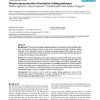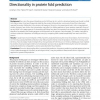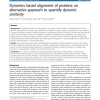13 search results - page 2 / 3 » Using motion planning to study protein folding pathways |
BMCBI
2005
13 years 5 months ago
2005
Background: The process of oxidative folding combines the formation of native disulfide bond with conformational folding resulting in the native three-dimensional fold. Oxidative ...
BMCBI
2010
13 years 19 days ago
2010
Background: Ever since the ground-breaking work of Anfinsen et al. in which a denatured protein was found to refold to its native state, it has been frequently stated by the prote...
BMCBI
2010
13 years 19 days ago
2010
Background: PDZ domain is a well-conserved, structural protein domain found in hundreds of signaling proteins that are otherwise unrelated. PDZ domains can bind to the C-terminal ...
BMCBI
2010
13 years 19 days ago
2010
Background: The dynamic motions of many proteins are central to their function. It therefore follows that the dynamic requirements of a protein are evolutionary constrained. In or...
SAC
2005
ACM
13 years 11 months ago
2005
ACM
The task of finding saddle points on potential energy surfaces plays a crucial role in understanding the dynamics of a micro-molecule as well as in studying the folding pathways ...



